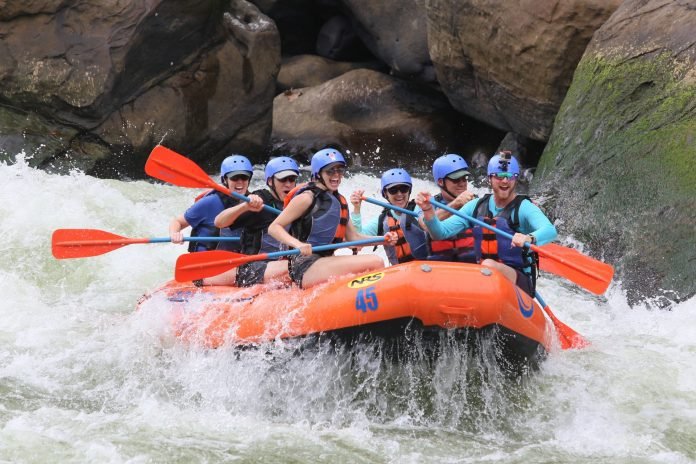Last Updated on February 14, 2024 by Nasir Hanif
Whitewater rafting can be a thrilling and fun experience, but it’s important to stay safe while doing it. Here are three tips to help you do just that: always wear a life jacket, know your abilities and stay aware of your surroundings.
Table of Contents
Introduction
The following article will cover what safety precautions should be taken before whitewater rafting, how to keep yourself safe while on the water, and how to get back safely from an excursion. Let’s start with why you need a life jacket in the first place–because no matter how experienced or talented you may be at paddling or swimming, there is always the risk of being submerged underwater for some time due to exhaustion or capsizing. It doesn’t happen often but when it does happen even the strongest swimmers can find themselves in trouble without a life jacket. Second, know your abilities as well as the abilities of those you are whitewater rafting with. It’s important to be honest with yourself and others about your skill level so that you can all paddle together and help each other out when needed. Last, stay aware of your surroundings at all times. This means paying attention to the current, looking out for obstacles, and being aware of any changes in the weather. By following these three simple tips, you can help ensure a safe and fun experience for everyone involved in whitewater rafting.
What to wear while whitewater rafting?
When it comes to what to wear while whitewater rafting, it’s important to be prepared for a variety of weather conditions. In general, you’ll want to dress in clothes that can get wet and are lightweight and comfortable. It’s also a good idea to wear sunscreen, sunglasses and a hat. If it’s cold out, you’ll want to wear layers so that you can adjust as the temperature changes. In addition, it’s a good idea to bring a change of clothes for after the trip.
How to paddle and steer?
Whitewater rafting can be a lot of fun, but it’s important to stay safe while doing it. One of the most important things to remember is how to paddle and steer. Here are a few tips:
-When paddling, try to keep your strokes even and consistent. This will help you move the raft in the direction you want it to go.
-If you need to change course, use your paddle to point the raft in the new direction. You can also use this technique to slow down or stop the raft.
-To steer the raft, use your paddle to push against the side of the boat that you want to turn it. Be careful not to put too much pressure on your paddle, or you may end up capsizing the raft.
What to do if you fall out of the raft?
If you do happen to fall out of the raft, don’t panic. The first thing you should do is try to grab onto the side of the raft or a rope that is attached to it. If you can’t reach the raft, swim towards the shoreline or calmer water. Once you’re out of the current, stand up and assess the situation. If you’re not injured and the raft is still afloat, get back in as quickly as possible. If the raft has capsized, stay with it and wait for help to arrive.
How to get back into the raft if you fall out?
If you’ve fallen out of the raft and are able to get back in on your own, here’s how to do it:
-First, make sure the raft is stable and that there are no obstacles nearby that could cause you to fall out again.
-Then, carefully climb back into the raft. Be careful not to slip or lose your balance.
-Once you’re in, take a seat and hold onto the sides of the raft until you feel safe.
If you can’t get back into the raft on your own, have someone help you. One person should hold onto the raft while the other helps the person get back in.
How to stay safe in rapids?
When whitewater rafting in rapids, it’s important to remember the following tips to stay safe:
-Stay aware of your surroundings at all times. This means keeping an eye out for obstacles and being aware of any changes in the current.
-Never stand up in the raft unless you are sure it is stable. Standing up can cause you to lose your balance and fall out of the raft.
-If you do fall out of the raft, try to grab onto the side of the boat or a rope that is attached to it. If you can’t reach the raft, swim towards the shoreline or calmer water. Once you’re out of the current, stand up and assess the situation. If you’re not injured and the raft is still afloat, get back in as quickly as possible. If the raft has capsized, stay with it and wait for help to arrive.
By following these tips, you can help ensure a safe and fun experience for everyone involved in whitewater rafting.
What to do if you encounter a waterfall?
If you encounter a waterfall while whitewater rafting, don’t panic. The first thing you should do is try to stay calm and in control. Then, assess the situation and make a plan. Here are a few things you can do:
-If you can go over the waterfall, try to do so. This is the safest option and will minimize the risk of injury.
-If you can’t go over the waterfall, try to go through it. Rapids are often more dangerous than waterfalls, so this may be your best option.
-If you can’t go over or through the waterfall, try to get out of the raft and onto the shore. Be careful not to get swept away by the current.
What to do if your boat capsizes?
If your boat capsizes, you should:
– Remain calm
– Hold onto the boat and the inflated life jacket
– Keep your feet and hands together
– Kick toward the surface of the water
Whitewater rafting can be a thrilling and fun experience, but it’s important to stay safe while doing it. Here are three tips to help you do just that: always wear a life jacket, know your abilities and stay aware of your surroundings. By following these tips, you can help ensure a safe and fun experience for everyone involved in whitewater rafting.
Read also: 6 Common Boat Buying Mistakes and How to Avoid Them






















